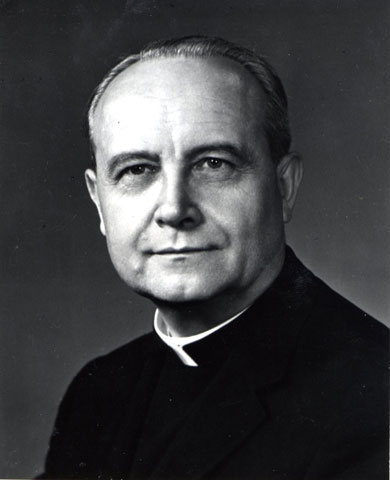
Maryknoll Fr. John J. Considine
 A WORLDWIDE HEART: THE LIFE OF MARYKNOLL FATHER JOHN J. CONSIDINE
A WORLDWIDE HEART: THE LIFE OF MARYKNOLL FATHER JOHN J. CONSIDINE
By Robert Hurteau
Published by Orbis Books, $45
Pope Francis, the Argentine Jesuit, has become a media phenomenon. His pastoral approach to the world's people and their problems has struck a universal chord of positive response. Where did he come from? Robert Hurteau's new book, A Worldwide Heart, makes no reference to the pope, but it provides an excellent historical context to help people understand the tremendous changes in Latin America during the 20th century.
Hurteau, a former Maryknoll priest, uses the personal history and worldwide missionary vision of Maryknoll Fr. John J. Considine (1897-1982) to show the evolution of Catholic missionary service and influence. Particularly, he chronicles how the church has changed in Latin America, where Considine was such a major figure.
In 1961, Pope John XXIII called for all communities of women and men religious in the United States to send 10 percent of their membership for mission service in Latin America within the decade. The figure was never reached, but all religious communities responded, as did diocesan clergy and lay missionary groups.
In 1955, in Rio de Janiero, a small group of Latin American bishops had begun what would become the Episcopal Conference of Latin America, known by its Spanish acronym, CELAM. The bishops of the United States began their Latin American Bureau in 1960, and Considine was named its first director. With the Second Vatican Council (1962-65), CELAM and the Latin American Bureau came into full flower, and the Catholic churches of the Western Hemisphere worked in closer collaboration than ever before. Meanwhile, the Cold War challenged all the countries and their colonial Catholic churches to a new awakening about social justice and cultural identity.
This missionary awakening by many was sharpened by the contrasting visions of Considine and Msgr. Ivan Illich, founder of the Intercultural Documentation Center in Cuernavaca, Mexico. Hurteau treats the conflict of these gifted protagonists at length.
Considine sought to organize the resources of the churches into collaborative action, working toward a maturity beyond colonial dependencies on outside help dating back to the Conquest. Illich touched the same issue in a controversial article in America magazine in 1967, "The Seamy Side of Charity." But Illich argued that the best solution was for missionaries, particularly priests, to simply leave Latin America, since their well-intentioned "charity" only continued ecclesial dependencies on the United States.
Those of us who worked as missioners on site in the last 40 years in Latin America know the importance of this missiological debate and dialogue. What now, in a globalized world of instant communication and interchange of resources, is "mission"? Does one country with superior personal and material resources "give" or "share" these resources with a dependent poor people out of faith? Is the Society of the Propagation of the Faith the model for mission sharing? How should it now be organized? What is its vision? Is "colonial" mission as we historically knew it outdated in its structures and strategies for a globalized, interconnected and interdependent world?
The worldwide heart of Considine was far ahead of his time trying to shape a vision of world church for the 21st century. Latin America became a laboratory for mission as a sharing of faith and culture. As Considine, the Maryknoll Fathers and Brothers, and other missionary groups had hoped, missioners learned from their people about culture and about real life. They learned about the human search for value, as indigenous cultures had long since discovered the sacred in the gifts of nature and of human life.
These missioners experienced the very real tensions of "colonial missiology" as a European "Mother Church" from the Vatican sought to protect the truth of traditional faith by clothing it only in the cultural customs and cloth of Europe -- a Europe closeted in its times and now rapidly passing away. They knew the frustrations of Fr. Matteo Ricci and other 17th-century Jesuit missionaries who sought to adapt the faith in the cultural milieu of China. That tension and frustration go back to Peter and Paul, the Acts of the Apostles, and their new global church welcoming gentiles into the community of Jesus-followers without the weight of kosher foods and customs.
Drawing on his organizational skills and missionary contacts from the 1920s, Considine brought together visionaries like himself with the leaders of the church in the Americas in the 1960s during and after Vatican II and helped them to structure their resources in new missionary activity. CELAM, the Latin America Bureau and the church communication networks and formation centers they created all over the Western Hemisphere spelled the end of a missiological myopia frozen in its colonial past.
These networks of communication brought missioners together to face the new challenges of Latin America as an active player on the front lines of the Cold War. Colonialism was dying all over the developing world. Peoples were emerging with a cry for independence and liberation. They wanted respect and sovereignty for their countries and their cultures. The missionary contribution in the last 60 years was not unique, but it was vital to this maturity of Latin American countries and their national Catholic churches. Still, it is over. It will never happen again. Nor will it be needed.
After 500 years of economic, political and ecclesial dependence, Latin America is ready to make its own contribution in the 21st century to a hopeful human future. Francis is only the beginning of Latin America's gifts to the church as he recalls for us the best of our faith. All Catholics, he says, are missionaries called to share their faith and life wherever they are in our global village.
[Fr. Michael J. Gillgannon, a priest of the diocese of Kansas City-St. Joseph, Mo., retired last year after 38 years in the diocesan mission serving the La Paz, Bolivia, archdiocese.]



